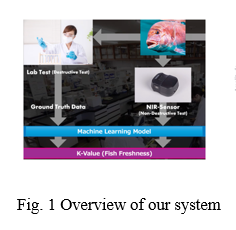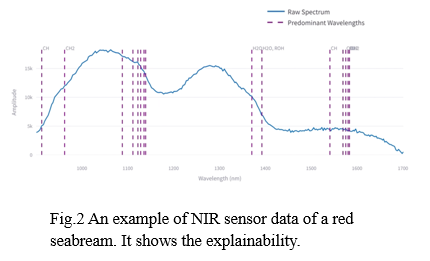REAL-TIME FRESHNESS EVALUATION OF FISH USING AI-DRIVEN NEAR-INFRARED SPECTROSCOPY: APPLICATION FOR POST-HARVEST VALUE ENHANCEMENT
Introduction
Post-harvest quality management is a critical issue in the global aquaculture industry. Fish prices are determined by species and weight, and the quality itself is often branded by origin by a few experts known as connoisseurs rather than by individual quality. By quantifying quality, it becomes possible to accurately reflect the value of fish in the market. Furthermore, in the supply chain of Japanese sea bream (Pagrus major), up to 15% of processed fillets are discarded annually due to uncertainty in freshness and subjective grading. This leads to a decrease in added value, increased food waste, and constraints on the predictability of shelf life. The K-value is a standard for evaluating the freshness of fish as per JAS (Japanes Agricultural Standards) regulations. Traditional K-value evaluation requires destructive, costly, and time-consuming laboratory HPLC analysis. To address emerging regulatory requirements and sustainability challenges (UN SDGs 12 and 14), we developed and validated a real-time, non-destructive freshness evaluation platform integrating handheld near-infrared spectroscopy (NIR) with advanced AI.
Materials and Methods
Sampling and Workflow: We sampled 1,178 skin-on fillets of [Pagrus major] farmed in the Sea of Japan over 0-7 days post-mortem, reflecting distinctive post-harvest conditions in Japan. The fillets were scanned at three standardized positions using two InnoSpectra MEMS NIR devices (900–1700 nm and 1350–2500 nm, 3 mm spot, 2-second acquisition). The scanning was implemented by workers using mobile or tablet interfaces during the packaging process.
Reference Method: The K-value ([HxR+Hx]/[ATP+ADP+AMP+IMP+HxR+Hx]×100) was measured by two inspection agencies, which measured samples on the day of slaughter and three days later. The two agencies measured the same samples simultaneously to confirm consistency in results.
Spectral Processing and Modeling: Each spectrum was processed using a triangular filter bank and differential feature extraction, then normalized (mean 0/variance 1, training set). Model Pipeline: RandomForestRegressor (scikit-learn), hyperparameters optimized with nested CV. An 80/20 split was used for training/testing sets (n=942/236), with 10-fold cross-validation conducted. Outliers (≤2%) were detected using Mahalanobis distance and excluded from model training. Cloud integration supported immediate result transfer and batch traceability.
Results
The NIR-AI platform achieved an MAE=1.62, RMSE=2.46, and R²=0.74 for K-value estimation in the test set, attaining a 91% category accuracy (Sashimi: K<20%, Cook: 20-40%, Reject: >40%), outperforming both baseline statistics and subjective evaluations. The shelf-life prediction curve using the NIR system matched observed spoilage and sensory cut-off points (average Δt <1 day). The real-time analysis results from the NIR sensor showed a high accuracy, with the Lab test K-value at 15 compared to our model’s analysis of 15.1.
Discussion and Impact
Comparison with State-of-the-Art: Unlike traditional linear regression or lab-supported NIR solutions, our deep learning and SaaS-connected approach enables real-time, operator-independent automation. Each test costs less than €0.002 (compared to €250 for HPLC) and can handle TEU-level processing capacity with five handsets per line.
Traceability and Scalability: The cloud-integrated results enable dynamic FIFO stacks, price optimization, and regulatory audit trails, essential for achieving EU Green Deal/"Farm to Fork" goals.
Deployment and Future Work
The current model is developed for sea bream, with plans to expand to other fish species. Pilot installations are scheduled for Mediterranean mackerel and bluefin tuna lines. Future upgrades will include outputs for microbial spoilage and nutritional components, as well as blockchain or digital twin features for farm-to-fork traceability. We are actively seeking collaboration with additional processing plants in the EU, NGOs, and retailers.
Conclusion
This study validated a real-time AI/NIR platform for fillet grading that directly addresses post-harvest value, waste, labor efficiency, and Green Deal SDG goals. This system establishes a new digital standard for aquaculture quality management in the EU and Japan.
Acknowledgements
We thank Akasaka Fishery, Ehime Institute of Industrial Technology, Merieux Nutrisceince Japan Corp. (formerly Bureau Veritas FEAC), InnoSpectra, Balfegó, and our technical, academic, and industrial partners. Part of this study was funded by the Triangle Ehime Promotion Project’s "Digital Implementation Acceleration Project".

